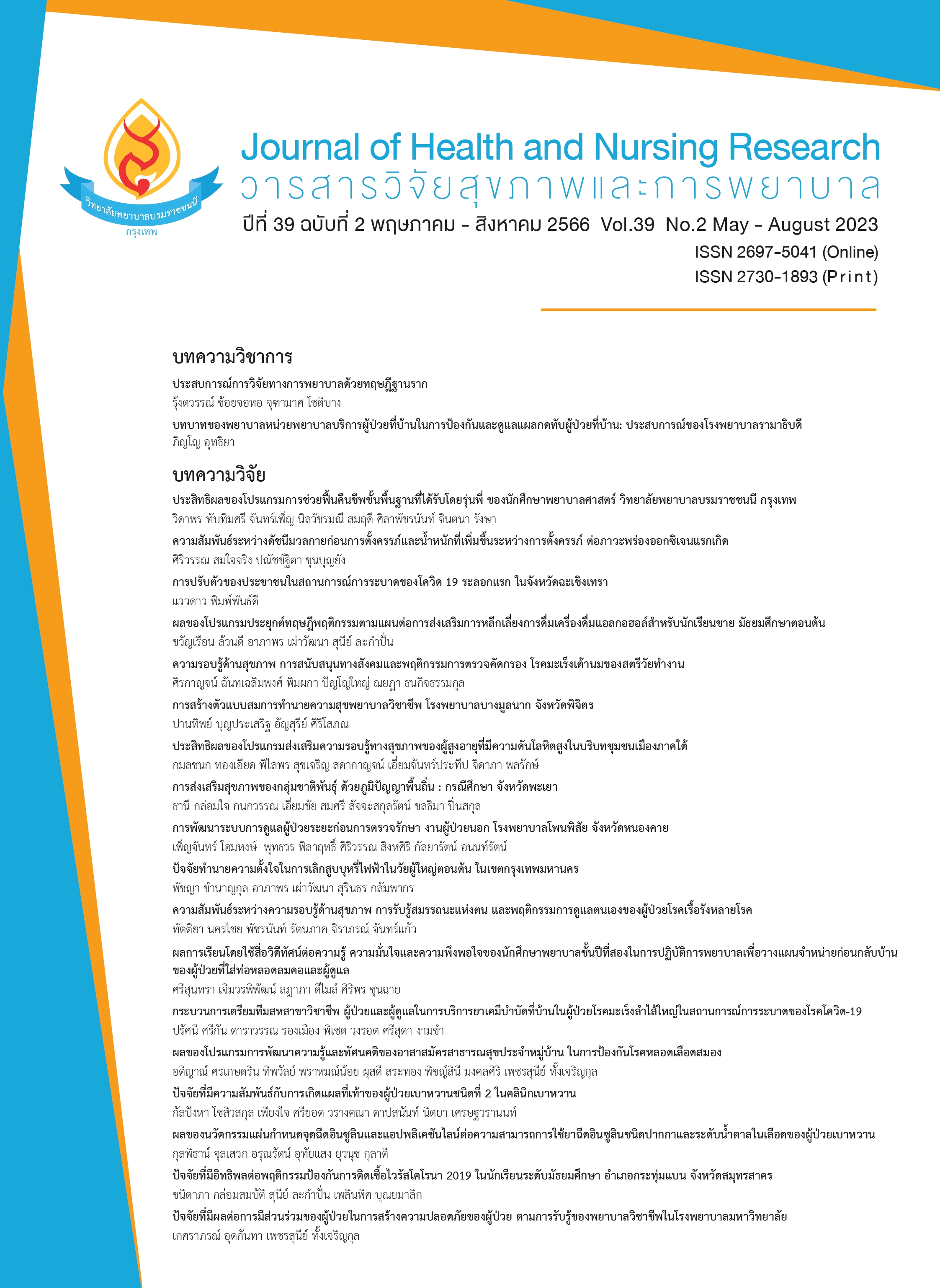บทบาทของพยาบาลหน่วยพยาบาลบริการผู้ป่วยที่บ้าน ในการป้องกันและดูแลแผลกดทับผู้ป่วยที่บ้าน: ประสบการณ์ของโรงพยาบาลรามาธิบดี
คำสำคัญ:
พยาบาลหน่วยพยาบาลบริการผู้ป่วยที่บ้าน , การป้องกันและดูแล , แผลกดทับบทคัดย่อ
บทนำ: แผลกดทับเป็นปัญหาสาธารณสุขสำคัญระดับโลก ส่งผลกระทบต่อคุณภาพชีวิตผู้ป่วยและครอบครัว พยาบาลหน่วยบริการพยาบาลผู้ป่วยที่บ้านเป็นบุคลากรสำคัญที่มีบทบาทในการป้องกันและดูแลแผลกดทับ
วัตถุประสงค์: เพื่อให้พยาบาลหน่วยพยาบาลบริการผู้ป่วยที่บ้านสามารถวางแผนการดูแลผู้ป่วยอย่างครอบคลุม มีเป้าหมายให้ผู้ป่วยและครอบครัวสามารถป้องกันและดูแลแผลกดทับที่บ้านได้อย่างมีประสิทธิภาพ
ประเด็นสำคัญ: พยาบาลหน่วยพยาบาลบริการผู้ป่วยที่บ้าน มีความจำเป็นต้องมีสมรรถนะเรื่องแผลกดทับ อันได้แก่ การป้องกันแผลกดทับก่อนที่จะเกิดแผลกดทับขึ้น โดยมีการประเมินความเสี่ยง ประเมินผิวหนัง การพลิกตะแคงตัว การใช้อุปกรณ์กระจายแรงกดทับ และการใช้ครีมป้องกันผิวหนังถูกทำลาย การมีความรู้เกี่ยวกับความหมายของแผลกดทับ การแบ่งระดับแผลกดทับที่เป็นระดับสากล ปัจจัยเสี่ยงที่ทำให้เกิดแผลกดทับ และปัจจัยที่ส่งผลต่อการหายของแผลกดทับ โดยบูรณาการบทบาทของพยาบาล ผ่านกระบวนการในการเตรียมความพร้อมผู้ป่วยและครอบครัวก่อนกลับบ้าน การเยี่ยมบ้าน ติดตามผ่านระบบ telecare และส่งต่อแหล่งประโยชน์สุขภาพในชุมชนดูแลต่อเนื่อง
สรุป: การป้องกันและดูแลแผลกดทับผู้ป่วยมีความสำคัญ พยาบาลหน่วยพยาบาลบริการผู้ป่วยที่บ้านมีบทบาทในการร่วมดูแลตั้งแต่อยู่ในโรงพยาบาลและติดตามดูแลต่อเนื่องที่บ้าน โดยมุ่งเน้นการมีส่วนร่วมของผู้ป่วยและครอบครัว
ข้อเสนอแนะ: พยาบาลหน่วยพยาบาลบริการผู้ป่วยที่บ้านควรมีสมรรถนะในการป้องกันและดูแลแผลกดทับ เพื่อนำไปพัฒนาระบบการป้องกันผู้ป่วยที่มีความเสี่ยงในการเกิดแผลกดทับตั้งแต่ผู้ป่วยรับการรักษาที่โรงพยาบาล โดยยึดผู้ป่วยและครอบครัวเป็นศูนย์กลาง
Downloads
เอกสารอ้างอิง
EPUAP, NPIAP, & PPPIA. Prevention and treatment of pressure ulcer/injuries: Clinical practice guideline. The International Guideline (E. Haesler, Ed.). EPUAP/NPIAP/PPPIA: 2019.
Haesler E. National pressure ulcer advisory panel, european pressure ulcer advisory panel and pan pacific pressure injury alliance. Prevention and treatment of pressure ulcers: quick reference guide[Internet] 2014.
Allman RM. Pressure ulcer prevalence, incidence, risk factors, and impact. Clinics in Geriatric Medicine 1997;13:421–36.
Coleman S, Gorecki C, Nelson EA, et al. Patient risk factors for pressure ulcer development: systematic review. Int J Nurs Stud 2013;50:974–1003.
Moore Z, Cowman S. Pressure ulcer prevalence and prevention practices in care of the older person in the Republic of Ireland. J Clin Nurs 2012;21:362–71.
Gress HB, Beresova A, Tkacova L, Magurova D, Lizakova L. Nurses' Knowledge and Attitudes towards Prevention of Pressure Ulcers. Int J Environ Res Public Health 2021;18:1-9.
Gedamu H, Abate T, Ayalew E, Tegenaw A, Birhanu M, Tafere Y. Level of nurses' knowledge on pressure ulcer prevention: A systematic review and meta-analysis study in Ethiopia. Heliyon. 2021;7:1-7.
Li Zhaoyu, et al. “Global prevalence and incidence of pressure injuries in hospitalized adult patients: A systematic review and meta-analysis. Int J Nurs Stud 2020;105: 1-13.
The pressure injury subcommittee, Ramathibodi Hospital. Pressure injury annual report. Faculty of Medicine Ramathibodi Hospital; 2022. (in Thai)
Home health Care, Ramathibodi Hospital. Pressure injury annual report. Faculty of Medicine Ramathibodi Hospital; 2022. (in Thai)
Edsberg, L. E., Black, J. M., Goldberg, M., McNichol, L., Moore, L., & Sieggreen, M. Revised National Pressure Ulcer Advisory Panel Pressure Injury Staging System: Revised Pressure Injury Staging System. J Wound Ostomy Continence Nurs 2016;43:585-597.
Rodgers K, Sim J, Clifton R. Systematic review of pressure injury prevalence in Australian and New Zealand hospitals. Collegian 2021;28 310-323.
European Pressure Ulcer Advisory Panel, National Pressure Injury Advisory Panel and Pan Pacific Pressure Injury Alliance. Prevention and Treatment of Pressure Ulcers/Injuries: Quick Reference Guide. Emily Haesler (Ed.). EPUAP/NPIAP/PPPIA:2019.
Guo S, Dipietro LA. Factors affecting wound healing. J Dent Res 2010;89:219–29.
Artico M, Angelo DD, Piredda M, Petitti T, Lamarca L, Marinis MGD, et al. Pressure Injury Progression and Factors Associated With Different End-Points in a Home Palliative Care Setting: A Retrospective Chart Review Study. Journal of pain and symptom management 2018;56:23-32.
Palmer, D. Physiotherapy Wound Care Programe. Factors Affecting Wound Healing. Plus. 2022.
Tipton CD, Wolcott RD, Sanford NE, Miller C, Pathak G, Silzer TK, et al. Patient genetics is linked to chronic wound microbiome composition and healing. PLoS pathogens 2020;16:1-22.
Ateeq I, kennedy L, Baby T, Amer IC, hehab F, Salim N. Associated Risk Factors and Barriers of Pressure Injury Wound Healing Process: A Retrospective Study of Single-Center Experience. Dubai Medical Journal 2022;5:163-170.
T. H. Chan School of Public Health, Harvard University. The nutrition source: Vitamin D. [Internet]. 2023 [cited 2023 March]; Available from: https://www.hsph.harvard.edu/nutritionsource/ vitamin-d/.
Garbarino S, Lanteri P, Bragazzi NL, Magnavita N, Scoditti E. Role of sleep deprivation in immune-related disease risk and outcomes. Commun Biol 2021 Nov 18;4(1):1-7.
Hathirat S. Family medicine handbook. 3rd ed. Bangkok: Mor Chaw Ban: 2012 (in Thai)
ดาวน์โหลด
เผยแพร่แล้ว
รูปแบบการอ้างอิง
ฉบับ
ประเภทบทความ
สัญญาอนุญาต
ลิขสิทธิ์ (c) 2023 วารสารวิจัยสุขภาพและการพยาบาล (วารสารวิทยาลัยพยาบาลบรมราชชนนี กรุงเทพ)

อนุญาตภายใต้เงื่อนไข Creative Commons Attribution-NonCommercial 4.0 International License.
บทความที่ได้รับการตีพิมพ์ เป็นลิขสิทธิ์ของวารสารวิจัยสุขภาพและการพยาบาล (วิทยาลัยพยาบาลบรมราชชนนี กรุงเทพ) ไม่สามารถนำไปตีพิมพ์ซ้ำในวารสารฉบับอื่น


















